I am walking the shoreline of Loch Creran on the West Coast of Scotland. This is a personal challenge which I hope will also be inspiring, you can read more about it here.
My husband dropped me off at the bay around the corner from Rubha Garbh. The first thing that struck me was the beautiful orache plants in between the rocks. I picked some for lunch. More wild plants caught my attention, the stunning yellow irises and then the bright pink raggin robin at the woodland edge.
- Stunning irises.
- Orache.
- Ragged Robin flowers.
Nature, our world, is such a gorgeous abundant place, she is green, green green and oh so lush. One of the permaculture principle comes to mind;
Use Edges & Value The Marginal.
You can read more about this and the other principles here. I love the principles of permaculture and try to apply them to my life as much as I can. Learning about permaculture was life transforming for me and lauched me off on a whole new trajectory in my life. It got me engaged with the care of life on earth and wanting and trying to do something about preserving it and about living in a more kind and ethical way.
“In human society, edge is where we have cultural diversity. It is the place where free thinkers and so-called ‘alternative’ people thrive, where new ideas are allowed to develop and ageless wisdom is given its rightful respect.” Mother Earth News.
Yo, that’s the place for me.
- Woodland by the shore.
- Lush grass.
- Alder all along the woodland edge.
Looking back round the bay the rocky glacial debris is evident. it’s amazing to think these big rocks were deposited here thousands of years ago and here they have stayed to tell their story. It’s fantastic to know this and feel that deep connection back in time. The landscape teaches us and informs us about the journey of our planet home, if we let it. It’s all to easy in a society like ours to get lost in the story of now, of business as usual, like this will go on forever. It won’t and it can’t. Our modern western societies have been wrecking the planet and her eco-systems at an unbelievable rate, climate chaos, peak oil, mass species extinction, economic collapse and gross human suffering is upon us and the sooner we wake-up out of our collective denial about it the better. 
Ok enough of that. I could rant on at great length but I’m sure that’s enough for you to get the gist of where I’m coming from, my edges!
Whoever lives in the next house must be simply oozing with gratitude to live in such a delightful place. They have this lovely little boat house with strategically placed bench to enjoy the loch views and a wee boat, how wonderful.
- A little boat house and bench.
- The boat.
Having enjoyed a trash free walk so far I then came across this strange amount of cable all along a fence, very odd indeed. Also stuck in the rock, a bolt. I wish I had counted all the bolts and rings I’ve seen embedded in rocks along the shore line. I suppose they have been used for mooring boats, and now with more modern methods, or because we have moved on from certain ways of living they remain as rusty evidence of these past-times.
- Fence with cables.
- Lots of cable.
- Bolt in the rocks.
The next photos, of rocks, has taken me off on a wee detour. I have just spent the last hour pouring over the British Geological Survey Map for Argyll. Interestingly this end of the loch, on both sides, contains at least 4 different types of rock. Most of the rest of the loch edge is made up of what the map describes as ‘Undivided Glen Creran only’.
The holes in these rocks shown below reminded me of the holes left by pyrites in slate. ” But there’s no slate here I thought.”
Wrong!
It turns out that this area of the loch contains Ben Eagach Schist and Easdale Slates. SO, I guess that’s what this is. All the rocks around here are metamorphic, meaning that they have been through incredible heat and pressure and have changed from what they were into what we see now. The rocks around this area belong to the Dalradian Supergroup, which means they are 800 to 500 million years old. You can read more about them here.
On Map 3 below you can see all these different rocks running from the South Shian side to the North Shian side of the loch. Looking at this map makes me think of plasticine. Imagine taking a load of different colours and mashing them all up together, that’s what we have here, swathes of different rocks all over the place. The earth sure is a dynamic place.
- 1 – British Geological Survey map of Argyl.l
- 2 – Loch Creran.
- 3 – Close up of Loch Ceran.
Looking at Map 1 you can see just how mixed up all the rocks are. Its hard to imagine this mass movement of the earth, all the twisting, crushing, all the incredible pressures which split land masses apart, and changes one form of rock into another. Most of us who live on it’s surface have no day-to-day notion of the immense movement going on below us. I guess those who live on active fault lines, near volcanoes and in earthquake regions are reminded of the fragility of their existence more often than those of us who ‘appear’ to live somewhere stable.
- Looking across bay to rocky island.
- Rocky shore.
- One monster rock.
The slate outcrop starts as I enter another bay. On the far side is a rocky island which sadly I could not get out to as the tide was too far in. From here the shore became a mass of rocks before another climbing expedition ensued.
- Looking back towards rocky island.
- Looking across the bay to the beginning of my walk.
I enjoyed climbing over these rocks, looking down into the barnacle clad lower reaches and the seaweed wafting in the tide. This section took me out to Rubha Riabhach, the point almost opposite where I live. Along the way I spotted all the amazing rocks below. All around this area the rocks were smoothed out which must be from the action of the tide coming in and out of the loch, I guess it’s because this point sticks right out and marks the corner where the loch turns and heads north east.
- Layers of rock.
- Quartz seam.
- Smoothed out rock.
- A thin seam of something.
- smoothed out rocks.
- Looking down into the loch.
The point itself was marked by this amazing yellow lichen. It must like being out and exposed.
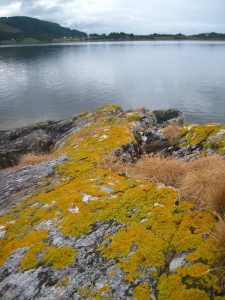
Obviously I stopped here to have a cuppa and enjoy the view. This is the point right opposite where I live and around which I watch all the yachts travel in and out of the loch.
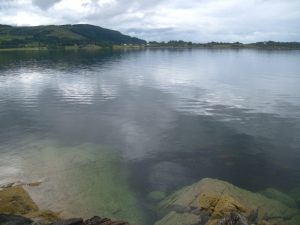
It felt quite odd to be sitting there looking back from the view which is so very familiar to me, the view from my chair in fact, where it all began.
Rounding that point felt significant, the end of this walk is coming, and what then?
On the way into the next bay I passed this split rock. I wonder when that happened? It must have landed with a bit of a thump somehow. The rocks change again and I suspect I am in the slither of Schiehallion and Jura Quartzites, only guessing though. It’s all a bit confusing since I also saw quartz seams on the other side of the point. How I wish I had a larger scale geological map, I have had to put on my reading glasses and use my compass magnifier to try and work out what is going on where.
- Little bay around from Rubha Riabhach.
- Split rock.
- More unusual rock.
Around this bay there are seams of clay as seen almost all the way around the loch. This one is particularly noticeable and interesting because it show the topsoil above. Leaving the bay I pass another ring plus lots more beautiful rocks. I wonder if these are the thin section of Appin limestone? At least that’s what I think it might be, it’s so thin on the map it’s hard to tell. Any geologists out there who can confirm?
- Another ring.
- Rails.
- Beautiful rocks.
- Beautiful rocks.
- Ring in rock.
- Topsoil above clay.
The next section of shore took me past this cute little bay, more amazing rocks and this poor tree. It reminded me of the photos of turtles whose shell growth has been distorted by plastic bands they get caught up in. Flipping plastic it’s causing problems everywhere.
- Cute little bay.
- More amazing rocks.
- Poor tree.
After scrambling over more rocky shore-line I had built up quite a sweat. I chanced upon a perfect little spot for a dip. I wasn’t about to swim around out of my depth alone or anything ( I get a bit scared), but a quick dip in this little bit with no nasty scary seaweed was too tempting to miss. I whipped of my clothes and slipped in. It was lovely.
- Clothes off.
- Swimming spot.
I don’t skinny dip very often, but it is a lovely way to swim. Last time I did it was first thing in the morning, in Croatia, in July straight off the back of the boat into crystal clear water, just a tad different! Swimming in the sea is so very refreshing, why don’t I do it more often…..I’ve got a wetsuit now, so no excuses except I think I need a swimming friend, that’s what, I’m a bit scared to go on my own.
So last section of walk takes me into North Shian bay. Half way round there is a rather odd looking pointy house right on the shore. They seem to be trying to reclaim some land from the sea with big stone-filled wire cages.
- North Shian Bay.
- Looking across towards South Shian bay.
- Shells.
- Lovely wee burn.
- Burn beside pointy house.
- Pointy house.
I made my way back up to the lane beside the burn which runs down next to this house. You can see the wire and stone land reclamation to the right of the burn. It goes all the way along the shore-line of their property encasing a clipped to attention lawn.
My day ends with a lovely stroll back along the North Shian lane while waiting for my husband to come and collect me.
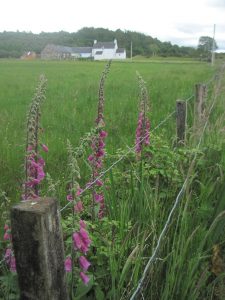
Foxgloves.



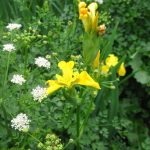
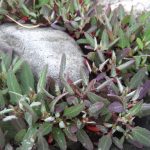
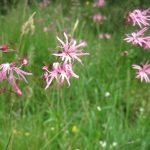
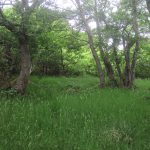
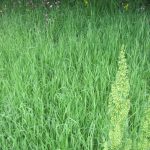
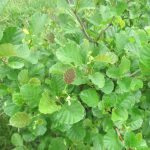

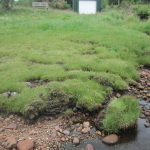
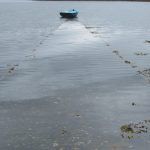
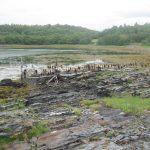

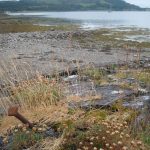
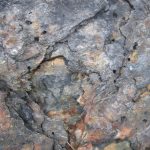
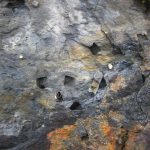
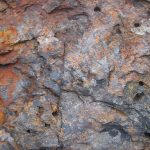

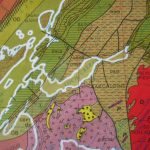



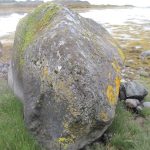
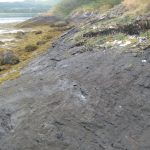
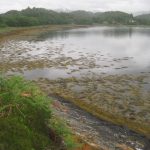
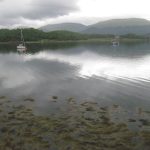
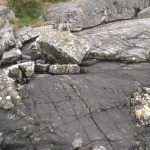
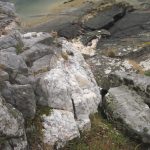
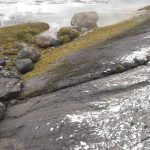
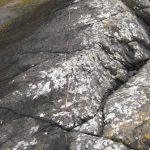
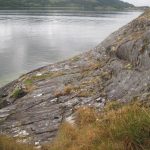
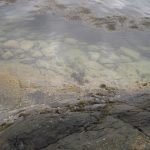

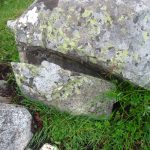
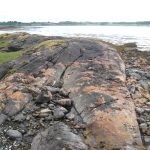
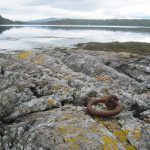
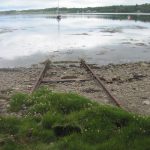
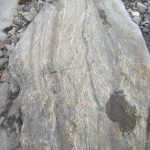
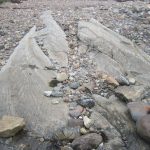

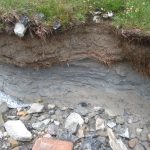
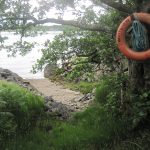

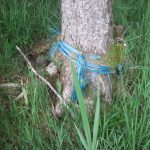


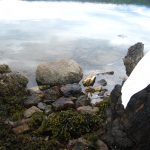
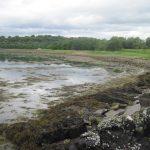

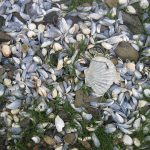
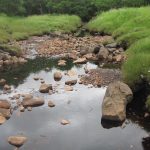
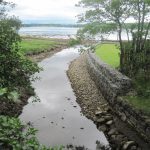
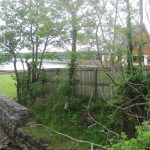

The pointy house was built by a professor Sidwell who spent the summer in Appin and winter in New Zealand – he built a few houses along that stretch of road. He was a proper self-builder who designed and built them all himself, utilising rainwater-collecting devices etc. He was an interesting chap. It’s now owned by a chap from Livingston who owns a plant hire company – a lot of his plant has been used to create the perfectly level surfaces you see now, including the seashore reclamation.
Thanks for this Alasdair, it’s great to hear more about these places I have seen.